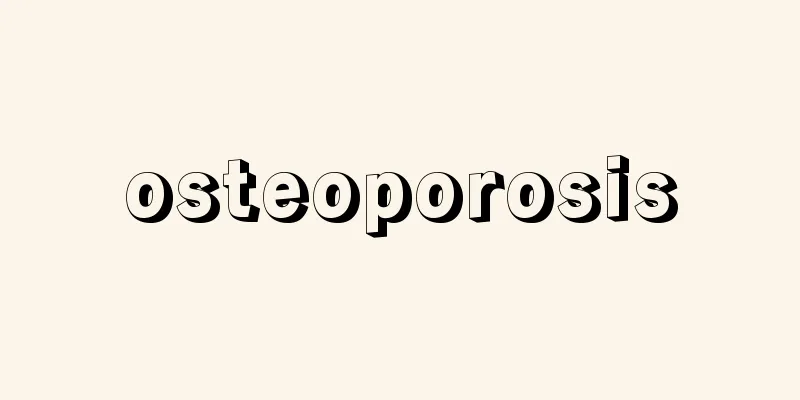osteoporosis

|
Definition and Concept Osteoporosis is a condition in which bones become brittle due to a decrease in bone strength, increasing the risk of fracture. Bone strength reflects both bone density and bone quality, while bone quality is affected by bone structural characteristics and material properties such as the degree of mineralization, collagen cross-linking components, and microdamage (Figure 13-6-5). Classification Osteoporosis is broadly classified into primary osteoporosis and secondary osteoporosis depending on the cause of its onset (Table 1 3-6-6). The majority of primary osteoporosis is postmenopausal osteoporosis seen in postmenopausal women and male osteoporosis seen in elderly men. In addition to these, there are rare cases of rapidly progressing idiopathic osteoporosis such as juvenile osteoporosis and post-pregnancy osteoporosis. Recently, it has been revealed that some cases of juvenile osteoporosis are due to abnormalities in the Wnt signaling system. Secondary osteoporosis has a wide variety of causes, including steroid-induced osteoporosis caused by Cushing's syndrome or steroid drug administration, immobile osteoporosis caused by prolonged bed rest, as well as endocrine diseases such as hyperparathyroidism and hypogonadism, inflammatory diseases such as rheumatoid arthritis, severe hepatic and biliary diseases such as primary biliary cirrhosis, and gastrointestinal diseases such as after gastrectomy and malabsorption syndrome. Causes and Etiology Bones support the body against gravity and maintain motor function, while also acting as a calcium storehouse, mobilizing calcium as needed. To perform these functions, bone mass and strength are maintained by removing old and damaged areas through bone resorption and mobilizing calcium, while promoting bone formation in necessary areas in response to mechanical loads. In this way, active remodeling is carried out by repeating bone resorption and bone formation. Furthermore, by maintaining a coupling between the bone resorption and bone formation processes, bone structure, mass, and strength are maintained. Osteoporosis is brought about when the equilibrium of bone metabolism during this remodeling is disrupted due to various causes. In healthy adults, even after the rapid height increase that occurs during puberty stops, bone mineral density continues to increase for a while, reaching peak bone mass around age 20. A steady state is then maintained for a while (young adult mean: YAM), but when bone metabolic equilibrium becomes negative with menopause and aging, bone volume remains roughly constant while bone mineral density decreases, and bone quality changes due to deterioration of structure and material, leading to a progressive decrease in bone strength. Epidemiology: Osteoporosis is primarily a disease of the elderly, and its incidence is rapidly increasing due to the aging of society. Approximately 30% of women in their 60s, 45% in their 70s, and 55% in their 80s are diagnosed with the disease. Approximately one-third of men are also patients, and the proportion of men increases with age. If both types of disease are combined, it is estimated that there are already nearly 13 million patients in Japan. Pathophysiology 1) Postmenopausal osteoporosis Sex hormones, particularly estrogen, have a major impact on maintaining the equilibrium between the bone resorption and bone formation systems. Estrogen maintains bone metabolic equilibrium by suppressing bone resorption through the inhibition of local production of bone-resorbing cytokines, such as interleukin (IL)-1, IL-6, and tumor necrosis factor (TNF), in the bone. For this reason, the decline in estrogen after menopause leads to osteoporosis, mainly due to increased bone resorption and bone turnover. 2) Male osteoporosis As we age, the production of growth factors involved in promoting bone formation is reduced, which inhibits osteoblast differentiation, resulting in a decrease in bone formation along with the synthesis of bone matrix proteins. On the other hand, bone resorption is not inhibited and exceeds bone formation relatively, resulting in a breakdown in the balance of bone metabolism and osteoporosis. 3) Immobilization osteoporosis Mechanical stress on bone is the most important physiological stimulus for bone formation, and a decrease in mechanical stress leads to increased bone resorption and decreased bone formation. As a result, a strong negative balance in bone metabolism is brought about, and osteoporosis progresses rapidly. 4) Steroid osteoporosis Chronic excess of glucocorticoids strongly suppresses bone formation, and coupled with the negative calcium metabolic balance caused by the inhibition of intestinal calcium absorption and renal tubular calcium resorption, it significantly negatively affects bone metabolic balance, leading to severe osteoporosis within just six months (Figure 13-6-6). For this reason, the guidelines recommend that in cases where 5 mg/day or more of prednisolone equivalent is being administered or is planned to be administered, treatment with bisphosphonates or similar drugs be used (Figure 13-6-7). Clinical manifestations 1) Symptoms: Nearly all non-vertebral fractures are clinical fractures that have symptoms, but many vertebral fractures occur without symptoms. If the fracture is thought to have occurred due to an external force equivalent to a fall from a height less than one's own height, such as a fall, it can be considered a fragility fracture due to decreased bone strength, regardless of whether it is vertebral or non-vertebral. Vertebral fractures can cause activity restrictions and lower back pain due to spinal deformities such as kyphosis, as well as gastrointestinal symptoms such as gastroesophageal reflux disease and respiratory symptoms such as an increase in respiratory infections due to decreased respiratory function, and nerve compression due to vertebral collapse can cause nerve paralysis of the lower limbs and radiating pain. 2) Objective findings: In cases where a vertebral fracture is present, symptoms such as a decrease in height and kyphosis of the spine are observed. In cases where height measurement shows a decrease of 2 cm or more, or where the back of the head is away from the height gauge when the head is facing forward, there is a high possibility of a vertebral fracture. Test results 1) Ca-PTH system: In primary osteoporosis, such as postmenopausal osteoporosis and male osteoporosis, there are no abnormalities in the calcium metabolic regulatory system, and therefore serum calcium and PTH concentrations are both normal. If abnormalities are found in these, it is necessary to keep in mind the possibility of secondary osteoporosis or osteomalacia associated with calcium metabolic disorders when carrying out differential diagnosis. 2) Bone X-ray: The presence or absence of a vertebral fracture is examined using bone X-rays. A vertebral fracture is determined to be present if a lateral X-ray of the vertebral body shows a reduction in vertebral height of 20% or more at the center or contralateral vertebral edge compared to the vertebral height of the anterior or posterior edge. Furthermore, a semi-quantitative severity assessment is also performed as appropriate, with a reduction in height of 20-25% indicating a mild vertebral fracture, 25-40% indicating a moderate vertebral fracture, and 40% or more indicating a severe vertebral fracture. 3) Bone density: Dual-energy x-ray absorptiometry (DXA) measurements of the lumbar spine or proximal femur are a good indicator of bone mineral density loss. Peripheral quantitative CT (pQCT) and peripheral DXA (pDXA) of the distal radius reflect primarily cortical bone mineral density, with slightly more cancellous bone in the distal radius. 4) Bone metabolism markers: This method specifically evaluates both processes by measuring trace components released from cross-linking components of bone matrix collagen due to bone resorption, and proteins secreted by osteoblasts at various stages of bone formation in blood and urine. Currently, serum bone alkaline phosphatase (BAP) and serum type I procollagen-N-propeptide (P1NP) are covered by insurance for bone formation, and urinary and serum type I collagen cross-linking N-telopeptide (NTX), urinary type I collagen cross-linking C-telopeptide (CTX), and urinary deoxypyridinoline (DPD) are covered by insurance for osteoporosis. Measurement of osteocalcin in patients with hyperparathyroidism is covered by insurance. Since bone resorption markers reflect changes in bone metabolism already 3 months after the start of treatment, bone metabolism markers are used to assist in the early diagnosis of osteoporosis and to evaluate the effectiveness of treatment. Since bone metabolism markers can evaluate changes in bone metabolism caused by treatment over time, they are useful for evaluating drug compliance and evaluating the effectiveness of treatment. There are also reports showing that high bone metabolism markers are themselves a risk factor for fracture independent of bone mineral density, and that improvements in bone metabolism markers are an indicator of fracture prevention effects. Diagnosis The most serious and frequent complication of osteoporosis is fracture, and diagnosis must be made while keeping in mind the indications for treatment to prevent fractures. The diagnostic criteria for osteoporosis, revised in 2000, formulated by the Japanese Society for Bone and Mineral Research, are used to diagnose osteoporosis (Table 13-6-7). According to these criteria, if bone mineral density is 80% or more of the young adult average (YAM) and no osteoporosis is observed on X-rays, the patient is deemed normal. In other cases, a differential diagnosis of diseases similar to osteoporosis and secondary osteoporosis is made based on interviews and other clinical information. If a fragility fracture is observed after exclusion diagnosis, the patient is diagnosed with primary osteoporosis. Even if there is no fracture, if the bone mineral density is less than 70% of the YAM, the patient is diagnosed with primary osteoporosis. If there is no fragility fracture and the bone mineral density is between 70% and less than 80% of the YAM, the patient is diagnosed with bone loss. Meanwhile, the WHO has developed the fracture risk assessment tool FRAX, which extracts risk factors that increase the absolute risk of fracture based on large-scale epidemiological studies and uses these factors to estimate the risk of fracture over the next 10 years online. In Japan, in addition to the above diagnostic criteria, guidelines for the prevention and treatment of osteoporosis have been developed to more accurately guide patients who are estimated to be at high risk of fracture to treatment. In the 2011 revised version, the criteria for initiating drug treatment were revised and combined with FRAX (Figure 13-6-8). Differential diagnosis: In parallel with the evaluation of fractures and bone density, diseases other than osteoporosis are excluded through blood biochemistry tests and bone X-rays. It is important to accurately exclude diseases that require completely different treatment methods, such as osteomalacia, which causes a decrease in bone density due to impaired bone mineralization, and diseases that cause pathological fractures due to bone destructive lesions such as bone metastasis from malignant tumors and multiple myeloma. Complications The most serious complication of osteoporosis is fractures. Proximal femoral fractures are the most serious of these, with approximately 150,000 reported cases in 2007 and the number continuing to increase. Bone mineral density and existing fractures are important predictors of fracture occurrence. A meta-analysis of elderly white women reported that a one standard deviation (SD) decrease in BMD approximately doubles the fracture rate. A history of fracture is also an important predictor of new fractures; even if BMD is the same, people with a history of fractures have approximately twice the risk of future vertebral and non-vertebral fractures compared to those with no history of fractures. The risk of new vertebral fractures is approximately seven times higher in those with three or more vertebral fractures than in those with no vertebral fractures, and approximately nine times higher in those with at least one severe vertebral fracture. The presence of a severe vertebral fracture is also an important predictor of non-vertebral fractures. Course and prognosis: Fractures are the second most common cause of bedridden patients in Japan after stroke, excluding senility, accounting for nearly 10% of all cases. When patients become bedridden, their prognosis worsens due to complications such as hypoxia pneumonia. The five-year survival rate after a proximal femoral fracture is extremely poor, at 50% for women aged 75 years or older and only 20% for men. On the other hand, vertebral fractures have been thought to worsen the quality of life but do not shorten the lifespan. However, there are studies showing that patients with three or more vertebral fractures have a four times higher mortality rate than those without any fractures. The five-year survival rate after a vertebral fracture is clearly worse than that of the general population, at 60% for women aged 75 years or older and 45% for men. It has become clear that vertebral fractures are also an important factor in worsening the prognosis of life. Treatment and Prevention 1) Therapeutic purpose: The primary goal of osteoporosis treatment is to prevent fragility fractures. For this reason, it is important to constantly evaluate the risk of fractures and make efforts to prevent them. 2) Lifestyle Guidance: Because fractures can occur from minor external forces or falls, it is necessary to first improve the home environment and take measures to prevent falls. In addition, moderate exercise is effective in maintaining bone strength and muscle power, so it is important to continue exercise and rehabilitation that is appropriate for each patient after understanding their overall condition. In patients who have been bedridden or in a nearly bedridden state for long periods due to other illnesses, it must be kept in mind that immobile osteoporosis may also cause a greater-than-expected decrease in bone strength, and it is desirable to start rehabilitation aimed at getting out of bed as soon as possible. Efforts should also be made to eliminate vitamin D deficiency by taking measures such as sunbathing, and to promote calcium intake through calcium-rich foods such as dairy products. 3) Drug treatment: Osteoporosis progresses without any noticeable symptoms, so the treatment rate is low, with only 20% of patients receiving drug treatment. Therefore, the prevention of fractures through the widespread use of osteoporosis treatment is a socially important issue. a) Bisphosphonates: Bisphosphonates are compounds in which the oxygen atom in the -P-O-P- structure of inorganic pyrophosphate is replaced with carbon. They bind with high affinity to hydroxyapatite, and when taken up by osteoclasts during bone resorption, they inhibit its function. As a result, they inhibit bone resorption and bone turnover, and have the effect of increasing bone density and preventing fractures. As the absorption efficiency of bisphosphonates from the intestinal tract is extremely low at less than 1%, they should be taken with a glass of water at least 30 minutes before breakfast, as a rule. In addition, to prevent esophageal ulcers and esophagitis, patients should avoid lying down for 30 minutes after taking the drug. For this reason, there is a problem in that the rate of continued use is low, despite the clear evidence of their effectiveness in preventing vertebral and non-vertebral fractures. Therefore, in parallel with the development of drugs with stronger bone resorption inhibitory activity, development has been progressing on formulations that can be administered intermittently for longer periods. The most widely used drugs, alendronate and risedronate, are both primarily taken once weekly, but in 2011, a once-monthly formulation of minodronic acid was introduced. b) Selective estrogen receptor modulators (SERMs): These drugs exhibit antagonistic effects on the breast and uterus, which are classic estrogen target organs, while exhibiting estrogen-like effects on bone and lipid metabolism. Raloxifene, the first SERM, reduced vertebral fractures by around 40% and also exhibited a cholesterol-lowering effect, and reduced the risk of estrogen receptor-positive invasive breast cancer by less than 50%, without increasing the risk of uterine cancer. It was approved in Japan in 2003, and has since become one of the leading osteoporosis treatments alongside bisphosphonates, replacing hormone replacement therapy using a combination of estrogen and progestin, which the Women's Health Initiative (WHI) study in 2002 showed increased risks of ischemic heart disease, stroke, total cardiovascular events, and invasive breast cancer. In 2010, bazedoxifene was approved as a new SERM. c) Teriparatide: Continuous administration of parathyroid hormone (PTH) promotes bone resorption and reduces bone mass, whereas intermittent administration enhances bone formation. As a result, it shows a significant increase in bone mass as well as an improvement in the structure of cancellous bone in particular. In a large-scale clinical trial conducted overseas, postmenopausal women with existing vertebral fractures were administered 20 μg of PTH (1-34) (teriparatide) subcutaneously daily for an average of 19 months. The results showed a significant increase in bone mineral density in both the lumbar spine and femoral neck, and the incidence of new vertebral fractures was reduced by 65% and nonvertebral fractures by 53%. In Japan, a multicenter clinical trial was conducted with a 12-month placebo-controlled double-blind comparison period and a 12-month open-label administration period in which all patients were administered 20 μg of teriparatide daily. The results showed an increase in bone mineral density in both the lumbar spine and proximal femur comparable to that seen in large-scale fracture prevention trials conducted overseas, and no safety issues were identified, including during the open-label administration period. Based on these results, daily self-injection of teriparatide subcutaneously for two years was approved in Japan in 2010, as in Europe and the United States. Furthermore, a once-weekly subcutaneous injection formulation of teriparatide at 56 μg was also approved in 2011. d) Alphacalcidol/eldecalcitol: In Japan, it is generally believed that the intake of both calcium and vitamin D is low, and so in treatment, the combined use of alphacalcidol, an active form of vitamin D, in addition to bisphosphonates and raloxifene has been recommended. A meta-analysis of clinical trials that investigated the fracture-inhibiting effect of alphacalcidol found that it was effective in inhibiting fractures in both vertebral and non-vertebral bodies. However, although a slight increase in bone density was observed in the vertebral body, it was not observed in the femur. On the other hand, because alphacalcidol has a fall-preventing effect, it is possible that a significant portion of its fracture-inhibiting effect is mediated through this fall-prevention effect. Recently, a new active vitamin D derivative, eldecalcitol, was shown to suppress vertebral fractures by 26% compared to alphacalcidol in a direct comparison test, and to suppress the occurrence of nonvertebral fractures, particularly forearm fractures, by 71%. It also increased bone density in the proximal femur as well as the lumbar spine, and femoral structural analysis using three-dimensional CT showed improved bone strength index. Although eldecalcitol's fall prevention effect has not been examined, it exceeded alphacalcidol in almost all items of QOL, including mental health, and in terms of safety, hypercalcemia was observed at roughly the same level. Based on these results, eldecalcitol was approved in Japan in 2011 as a new osteoporosis treatment. e) Other treatments: Vitamin K is a treatment approved only in Japan. It gamma-carboxylates glutamic acid contained in osteocalcin, but the details of its mechanism of action on bone are unknown, and its fracture prevention effect has not been proven. Calcitonin acts directly on osteoclasts and inhibits bone resorption. In Japan, insurance coverage is limited to the relief of pain caused by osteoporosis. [Toshio Matsumoto] ■ References <br /> Osteoporosis Prevention and Treatment Guidelines Editorial Committee (ed.): Osteoporosis Prevention and Treatment Guidelines 2011 Edition, Life Science Publishing, Tokyo, 2011. Lambert JK, Zaidi M, Mechanick JI: Male osteoporosis: epidemiology and the pathogenesis of aging bones. Curr Osteoporos Rep, 9: 229-236, 2011. Nawata H, Soen S et al: Guidelines on the management and treatment of glucocorticoid-induced osteoporosis of the Japanese Society for Bone and Mineral Research (2004). J Bone Miner Metab, 25: 105-109, 2005. Classification of osteoporosis "> Table 13-6-6 "Diagnostic criteria for primary osteoporosis (revised in 2000) (Modified from Hajime Orimo et al.: Diagnostic criteria for primary osteoporosis, revised in 2000, Osteoporosis Jpn 9: 9-14, 2001)" " > Table 13-6-7 Definition of osteoporosis and factors determining bone strength "> Figure 13-6-5 Mechanism of steroid-induced osteoporosis "> Figure 13-6-6 Guidelines for management and treatment of steroid-induced osteoporosis "> Figure 13-6-7 Criteria for starting drug treatment for primary osteoporosis Figure 13-6-8 Source : Internal Medicine, 10th Edition About Internal Medicine, 10th Edition Information |
|
定義・概念 骨粗鬆症(オステオポローシス)とは,骨強度の低下により骨が脆くなり骨折の危険性が高まった病態である.骨強度は骨密度と骨質の両者を反映し,骨質は骨の構造特性や,石灰化度,コラーゲン架橋成分,微小損傷など材質特性の影響を受ける(図13-6-5). 分類 骨粗鬆症はその発症原因により原発性骨粗鬆症と続発性骨粗鬆症に大きく分類される(表13-6-6).原発性骨粗鬆症の大部分を占めるのは,閉経後女性にみられる閉経後骨粗鬆症と,高齢男性にみられる男性骨粗鬆症である.これらのほかにも,まれではあるが若年性骨粗鬆症や妊娠後骨粗鬆症など急速に進行する特発性骨粗鬆症がある.最近,若年性骨粗鬆症例の一部に,Wntシグナル系の異常に基づく例が存在することが明らかとなっている. 続発性骨粗鬆症は,Cushing症候群やステロイド薬の投与によるステロイド性骨粗鬆症,長期臥床による不動性骨粗鬆症などのほか,副甲状腺機能亢進症,性腺機能不全症などの内分泌疾患や,関節リウマチなどの炎症性疾患,原発性胆汁性肝硬変などの重症肝胆道疾患,胃切除後や吸収不良症候群などの消化管疾患に伴うものなどきわめて多様な原因に基づく. 原因・病因 骨は重力に抗して身体を支え運動機能を保持するとともに,カルシウム貯蔵庫として必要に応じカルシウムを動員する役割を担っている.これらの機能を果たすため,古く損傷した部分を骨吸収により除去しカルシウムを動員しつつ,力学的負荷に応じて必要な部位の骨形成を促進することで,骨量,骨強度を維持している.こうして骨吸収と骨形成を繰り返すことにより活発な再構築(リモデリング)が営まれている.そして骨吸収過程と骨形成過程との間に共役関係(カップリング)が維持されることにより,骨の構造,量および強度が維持されている.骨粗鬆症は,この再構築における骨代謝平衡が種々の原因により破綻する結果もたらされる. 健常成人では,思春期の急速な身長の増加が停止した後もしばらくは骨密度の増加が続き,20歳前後で最大骨量(peak bone mass)に達する.その後しばらく定常状態が維持されるが(若年成人平均値,young adult mean:YAM),閉経や加齢に伴って骨代謝平衡が陰性化すると,骨容積はほぼ保たれたままで骨密度が減少するとともに,構造や材質の劣化により骨質も変化し,骨強度の低下が進行していく. 疫学 骨粗鬆症は基本的には高齢者の病気であり,社会の高齢化によりその頻度も急速に増加している.女性では60歳代で約30%,70歳代では約45%,80歳代になると55%程度が本症と診断される.男性でも女性の1/3前後の患者が存在し,加齢とともに男性の占める比率は増加する.両者を併せるとわが国ですでに1300万人近い患者が存在するものと推定されている. 病態生理 1)閉経後骨粗鬆症(postmenopausal osteoporosis) 骨吸収系と骨形成系との間の平衡関係の維持には,性ホルモンとりわけエストロゲンが大きな影響を及ぼす.エストロゲンは骨局所でのインターロイキン(IL)-1,IL-6,腫瘍壊死因子(tumor necrosis factor:TNF)などの骨吸収性サイトカインの産生抑制などを介して骨吸収を抑制的に制御し骨代謝平衡を維持している.このため閉経後のエストロゲンの低下は,おもに骨吸収と骨代謝回転の亢進による骨粗鬆症をきたす. 2)男性骨粗鬆症(male osteoporosis) 加齢に伴い骨形成の促進にかかわる成長因子の産生低下などにより骨芽細胞分化が抑制される結果,骨基質蛋白の合成などとともに骨形成が低下する.一方,骨吸収は抑制されず骨形成を相対的に上回る結果,骨代謝平衡が破綻し骨粗鬆症をきたす. 3)不動性骨粗鬆症(immobilization osteoporosis) 骨への力学的負荷は最も重要な生理的骨形成刺激であり,力学的負荷の減少は骨吸収の亢進とともに骨形成の低下をきたす.その結果,強い骨代謝平衡の陰性化がもたらされ,急速に骨粗鬆症が進行する. 4)ステロイド性骨粗鬆症(steroid osteoporosis) グルココルチコイドの慢性的過剰は強い骨形成の抑制をもたらすとともに,腸管Ca吸収と腎尿細管Ca再吸収を抑制することによるCa代謝平衡の陰性化とも相まって骨代謝平衡を大きく陰性化させ,わずか半年以内に高度の骨粗鬆症をきたす(図13-6-6).このため,プレドニゾロン換算5 mg/日以上を投与中または投与が予定される例ではビスホスホネートなどによる治療を行うことがガイドラインにより推奨されている(図13-6-7). 臨床症状 1)自覚症状: 非椎体骨折はほぼすべて症状を有する臨床骨折であるが,椎体骨折は症状のないまま発生するものが多い.転倒など,身長の高さ以下からの落下と同等の外力により骨折したと考えられる場合は,椎体・非椎体を問わず骨強度の低下による脆弱性骨折と考えてよい.椎体骨折をきたすと,円背など脊椎変形による活動制限や腰背部痛のほか,逆流性食道炎などの消化器症状,呼吸機能の低下による呼吸器感染症の増加などの呼吸器症状に加え,椎体圧潰によって神経が圧迫されると下肢神経麻痺や放散痛の原因となる. 2)他覚所見: 椎体骨折が存在する例では,身長の低下や脊柱の後彎などが認められる.身長測定により2 cm以上の低下がみられたり,頭部を正面に向けた姿勢で後頭部が身長計から離れるような例では,椎体骨折が存在する可能性が高い. 検査成績 1)Ca-PTH系: 閉経後骨粗鬆症や男性骨粗鬆症などの原発性骨粗鬆症ではCa代謝調節系には異常はなく,したがって血清CaやPTH濃度などはいずれも正常である.もしこれらに異常がみられた場合は,Ca代謝異常症に伴う続発性骨粗鬆症や骨軟化症などの可能性を念頭に鑑別を進める必要がある. 2)骨X線写真: 骨X線写真により椎体骨折の有無を検討する.椎体側面X線写真により前縁または後縁部の椎体高に比し中央部または対側椎体縁の椎体高が20%以上減高していれば椎体骨折ありと判定される.さらに,20〜25%の減高であれば軽症,25〜40%であれば中等症,40%以上であれば重症の椎体骨折とする半定量的な重症度評価も適宜行う. 3)骨密度: 二重エネルギーX線吸収装置(DXA)による腰椎または大腿骨近位部の測定が骨密度の低下を鋭敏に反映する.橈骨遠位部の末梢骨定量的CT(pQCT)や末梢骨DXA(pDXA)はおもに皮質骨の骨密度を反映し,超遠位部ではこれより若干海綿骨が多い. 4)骨代謝マーカー: 骨吸収により骨基質コラーゲンの架橋成分などから放出される微量成分や,骨形成の種々の段階で骨芽細胞より分泌される蛋白を血中や尿中で測定することにより,両過程を特異的に評価するものである.現在,骨形成マーカーのうち血清骨型アルカリホスファターゼ(BAP)と血清I型プロコラーゲン-N-プロペプチド(P1NP)が保険適応されているほか,骨吸収マーカーとして尿中・血中Ⅰ型コラーゲン架橋N-テロペプチド(NTX),尿中Ⅰ型コラーゲン架橋C-テロペプチド(CTX),尿中デオキシピリジノリン(DPD)が骨粗鬆症に対して保険適用を受けている.オステオカルシンは副甲状腺機能亢進症に対する測定について保険適用される.骨吸収マーカーは治療開始3カ月後にはすでに骨代謝動態の変化を反映することから,骨代謝マーカーは骨粗鬆症の初期診断の補助と治療効果の判定に用いられている. 骨代謝マーカーは治療による骨代謝動態の変化を経時的に評価することが可能なことなどから,服薬状態の評価や治療効果の判定に有用である.骨代謝マーカーの高値自体が骨密度とは独立した骨折の危険因子であるという成績や,骨代謝マーカーの改善が骨折防止効果の指標となるという成績も報告されている. 診断 骨粗鬆症の最も重大かつ高頻度にみられる合併症は骨折であり,骨折防止の観点から治療適応を念頭において診断を進める必要がある.骨粗鬆症の診断には,骨代謝学会により策定された診断基準2000年度改訂版が用いられる(表13-6-7).この診断基準では,骨密度が若年成人平均値(YAM)の80%以上で,X線像でも骨粗鬆化を認めないときには正常と判断し,それ以外の場合に問診その他の臨床的情報をもとに骨粗鬆症と類似した疾患,および続発性骨粗鬆症の鑑別診断を行う.除外診断の後に脆弱性骨折を認める場合には原発性骨粗鬆症と診断する.骨折なしの場合でも,骨密度がYAM 70%未満の場合には原発性骨粗鬆症と診断する.脆弱性骨折がなく,骨密度がYAM 70%以上〜80%未満の場合は骨量減少と診断する. 一方,大規模な疫学検討に基づき骨折の絶対リスクを高める危険因子を抽出し,これらの組み合わせからオンラインで将来10年間の骨折リスクを推定するツールとしてfracture risk assessment tool FRAXがWHOにより策定されている.わが国では,上記の診断基準に加え骨折リスクの高いと推定される患者をより的確に治療へと誘導するため骨粗鬆症の予防と治療のガイドラインが策定されている.その2011年改訂版では,FRAXとも組み合わせた薬物治療開始基準の改訂が行われた(図13-6-8). 鑑別診断 骨折や骨密度の評価と並行して血液生化学検査や骨X線写真などにより骨粗鬆症以外の疾患を除外する.骨軟化症など骨石灰化障害により骨密度の低下をきたす疾患,悪性腫瘍の骨転移や多発性骨髄腫などの骨破壊性病変により病的骨折をきたす疾患など,治療法がまったく異なる疾患を的確に除外することが重要である. 合併症 骨粗鬆症で問題となる重篤な合併症は骨折である.なかでも大腿骨近位部骨折は最も重篤で,2007年の統計で約15万人が報告されており,なお増加傾向が持続している. 骨折発生の予知因子としては骨密度と既存骨折が重要である.高齢白人女性を対象にしたメタ解析では,骨密度が1標準偏差(standard deviation:SD)低いと骨折率は2倍前後になると報告されている.骨折の既往も新たな骨折発生の予知因子として重要で,骨密度が同じでも骨折の既往がある人は,ない人に比べ将来の椎体・非椎体骨折の危険率は約2倍になる.新規椎体骨折の危険率は椎体骨折が3個以上ある場合は椎体骨折のない場合と比べ約7倍,重症椎体骨折が1個でもある場合は約9倍に増加する.重症椎体骨折の存在は非椎体骨折の重要な予知因子でもある. 経過・予後 骨折はわが国の寝たきり患者の原因疾患として,老衰を除くと脳卒中についで多く,10%近くを占めている.寝たきりになると,沈下性肺炎などの合併症を発症することなどにより生命予後も悪化する.大腿骨近位部骨折発生後の5年生存率は,75歳以上の女性では50%,男性では実に20%程度ときわめて悪い.一方,椎体骨折は生活の質の悪化を招くものの寿命までは短縮させないものと思われてきた.しかし,脊椎に3個以上骨折のある患者は1つも骨折のない人に比べ死亡率が4倍高いという成績もある.椎体骨折発生後の5年生存率は75歳以上の女性で60%,男性では45%程度と一般人口より明らかに悪く,椎体骨折も重要な生命予後の悪化因子であることが明らかとなっている. 治療・予防 1)治療目的: 骨粗鬆症治療の最大の目的は脆弱性骨折の防止である.このため骨折発生の危険性を常に評価し,その予防に努めることが重要である. 2)生活指導: 軽微な外力,転倒などにより骨折を起こし得るため,まずは家庭内の環境整備および転倒防止対策を講じる必要がある.また適度な運動負荷は骨強度および筋力維持に有効であり,各患者の全身状態を把握したうえでおのおのに応じた運動やリハビリテーションを継続させることも重要である.ほかの疾患で長期間寝たきりあるいはそれに近い状態にある患者では,不動性骨粗鬆症も加わり予想以上の骨強度の低下があることを念頭におく必要があり,なるべく早期の離床に向けてのリハビリテーション導入が望ましい.また日光浴などによるビタミンD不足の解消や乳製品などCaの豊富な食事によるCa摂取の促進にも努める. 3)薬物治療: 骨粗鬆症は自覚症状がないまま進行することなどのため治療率は低く,薬物治療を受けている患者は全体の20%余りにすぎない.したがって,骨粗鬆症治療の普及による骨折の防止は社会的にも重要な課題である. a)ビスホスホネート:ビスホスホネートは,無機ピロリン酸の−P−O−P−構造の酸素原子を炭素に置き換えた化合物で,ヒドロキシアパタイトに高い親和性を有して結合し,骨吸収に伴い破骨細胞に取り込まれるとその機能を抑制する.その結果,骨吸収・骨代謝回転を抑制し,骨密度増加・骨折防止効果を発揮する.ビスホスホネートは腸管からの吸収効率が1%以下ときわめて低いため,原則として朝食の30分以上前にコップ1杯の水とともに服用する.また食道潰瘍や食道炎を防止するため,服用後30分間は臥位を避ける.このため明確な椎体・非椎体骨折防止効果のエビデンスをもちながら服用継続率が低いという問題点がある.そこでより強力な骨吸収抑制活性をもつ薬剤の開発と並行して,より長期間欠投与が可能な製剤の開発が進められてきた.最も広く使用されているアレンドロネート,リセドロネートはいずれも週1回服用製剤が主流であるが,2011年にはミノドロン酸の月1回服用製剤が登場した. b)選択的エストロゲン受容体モジュレーター(selective estrogen receptor modulator:SERM):エストロゲンの古典的な標的臓器である乳腺や子宮などでは拮抗作用を示しながら,骨や脂質代謝に対してはエストロゲン様作用を示す.最初のSERMであるラロキシフェンは,椎体骨折を40%前後減少させるとともにコレステロール低下作用を示し,エストロゲン受容体陽性の浸潤性乳癌のリスクも50%以下に減少させ,子宮癌のリスクは増加させなかった.わが国では2003年に認可され,2002年にWHI(Women’s Health Initiative)試験により虚血性心疾患,脳卒中,全心血管系イベント,浸潤性乳癌をいずれも増加させることが明らかとなったエストロゲン・プロゲスチン併用のホルモン補充療法に代わって,ビスホスホネートと並んで骨粗鬆症の代表的治療薬の1つとなっている.2010年には新たなSERMとしてバゼドキシフェンが認可されている. c)テリパラチド:副甲状腺ホルモン(PTH)を持続投与すると骨吸収が亢進し骨量は減少するのに対し,間欠投与により骨形成機能が高まる.この結果,著明な骨量増加作用とともにとりわけ海綿骨の構造改善作用を示す.海外における大規模臨床試験では,既存の椎体骨折を有する閉経後女性においてPTH(1-34)(テリパラチド)20 μgを平均19カ月連日皮下投与した結果,骨密度が腰椎・大腿骨頸部ともに著明に増加し,新規椎体骨折発生率が65%,非椎体骨折も53%抑制された.わが国においても,プラセボ対照二重盲検比較期間12カ月,全例にテリパラチド20 μg/日を投与するオープン投与期間12カ月の多施設共同臨床試験が行われた.その結果,腰椎および大腿骨近位部骨密度はいずれも海外での大規模骨折防止試験と同等の増加を示すとともに,オープン投与期間を含め安全性に問題は認められなかった.以上の成績をもとに,わが国でも欧米と同様に2年間のテリパラチド連日皮下自己注射が2010年に承認された.さらに,2011年にはテリパラチド56 μgの週1回皮下注射製剤も認可された. d)アルファカルシドール・エルデカルシトール:一般にわが国ではCa,ビタミンDともに摂取量が少ないとされており,治療にあたってはビスホスホネートやラロキシフェンに加え活性型ビタミンDであるアルファカルシドールの併用がすすめられてきた.アルファカルシドールの骨折抑制効果を検討した臨床試験のメタ解析では,椎体・非椎体ともに骨折抑制効果ありとの成績がある.しかし骨密度増加効果は椎体では軽度みられるものの大腿骨ではみられていない.一方,アルファカルシドールは転倒防止効果を示すことから,その骨折抑制効果のかなりの部分が転倒防止効果を介する可能性もある. 最近新たな活性型ビタミンD誘導体エルデカルシトールが,アルファカルシドールとの直接比較による優位性検証試験により,椎体骨折をアルファカルシドールより26%抑制するのに加え非椎体のうち,とりわけ前腕骨折の発生を71%も抑制することが示された.また腰椎に加え大腿骨近位部の骨密度も増加させ,三次元CTによる大腿骨構造解析では骨強度指標を改善していた.エルデカルシトールの転倒防止効果は検討されていないが,QOLはメンタルヘルスを含めほぼすべての項目でアルファカルシドールを上回っており,安全性では高カルシウム血症がほぼ同程度認められた.これらの成績をもとにわが国ではエルデカルシトールが新たな骨粗鬆症治療薬として2011年に認可された. e)その他の治療薬:ビタミンKはわが国でのみ認可されている治療薬である.オステオカルシンなどに含まれるグルタミン酸をγ-カルボキシル化するが,骨への作用機序の詳細は不明で骨折防止効果は証明されていない.カルシトニンは破骨細胞に直接作用し骨吸収抑制作用を示す.わが国では骨粗鬆症による疼痛の緩和にかぎり保険適用されている.[松本俊夫] ■文献 骨粗鬆症の予防と治療ガイドライン作成委員会編:骨粗鬆症の予防と治療ガイドライン2011年版,ライフサイエンス出版,東京,2011. Lambert JK, Zaidi M, Mechanick JI: Male osteoporosis: epidemiology and the pathogenesis of aging bones. Curr Osteoporos Rep, 9: 229-236, 2011. Nawata H, Soen S et al: Guidelines on the management and treatment of glucocorticoid-induced osteoporosis of the Japanese Society for Bone and Mineral Research (2004). J Bone Miner Metab, 25: 105-109, 2005. 骨粗鬆症の分類"> 表13-6-6 "原発性骨粗鬆症の診断基準(2000 年改訂版)(折茂肇ほか:原発性骨粗鬆症の診断基準_2000 年度改訂版_,Osteoporosis Jpn 9: 9-14, 2001 より改変)""> 表13-6-7 骨粗鬆症の定義と骨強度の規定因子"> 図13-6-5 ステロイド性骨粗鬆症の発症機序"> 図13-6-6 ステロイド骨粗鬆症の管理と治療ガイドライン"> 図13-6-7 原発性骨粗鬆症の薬物治療開始基準"> 図13-6-8 出典 内科学 第10版内科学 第10版について 情報 |
Recommend
Design Ordinance - Design Ordinance
...Although there was some turmoil during the Fre...
Cathodic protection - Cathodic protection
...A technology that prevents corrosion of metal ...
Y organ - Waikikan
Located in the antennal or maxillary segments of ...
Pierre Klossowski
French writer and thinker. Born in Paris to paint...
Song sound - Soon
〘Noun〙 A type of Chinese character pronunciation. ...
Gable - Clark Gable
American film actor. Born in Ohio. After working ...
Bur‐cucumber
A naturalized plant of the Cucurbitaceae family th...
Shojuan
This temple is of the Myoshinji school of the Rinz...
Su Jun
A writer from the Northern Song Dynasty of China....
Atrichornithidae
… any of the birds of the family Atrichornithidae...
Ur-Nammu - Ur-Nammu
...In the second half of the 22nd century BCE, th...
Khural
…the highest decision-making body of the Mongol E...
Skoda [company] - Skoda
The largest company in the Czech Republic, a compr...
Inunoshita - dog tongue fish
A marine fish belonging to the order Pleuronectif...
Bombax malabaricum (English spelling) Bombaxmalabaricum
...Before World War II, Java and Sumatra were maj...









